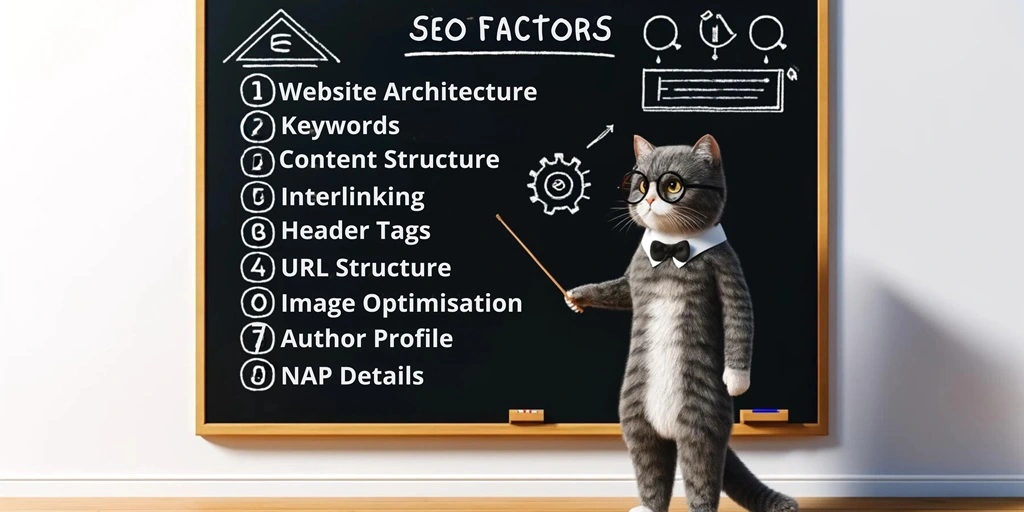A website is a digital shop through which we sell products and services. So, in order to make sure Google crawlers come and check the pages of our website, we have to make the things easier for the Google Crawlers. We have to make sure these crawlers are able to find the content on our pages easily so that Google can show that content to the our relevant users.
Now, when Google starts showing our pages to the users, we have to make sure that the title of the pages is appealing enough to the users to make them click and check the content out.
So, the process of designing these tags and titles for the Google Crawlers and users is called On Page SEO.
What is On Page SEO?
On Page SEO refers to the practice of optimizing individual web pages to improve their search engine rankings and attract more organic traffic. This involves optimizing both the content and HTML source code of a page. Unlike Off Page SEO, which involves external factors like backlinks, On Page SEO focuses on elements within the website.
Difference Between SEO and On Page SEO
SEO is a broad term encompassing all strategies used to improve a website’s search engine ranking. It includes both On Page SEO and Off Page SEO. On Page SEO deals with the elements within the website, such as content quality, keywords, meta tags, and user experience. Off Page SEO involves external factors, primarily backlinks from other websites.
What Are Different On Page SEO Elements?

- Website Architecture: Having a clean website Architecture is really important for easy discovery of the pages of the website.
- Keyword Research and Optimization: Identifying relevant keywords and incorporating them naturally into your content.
- Meta Tags Optimization: Crafting compelling meta titles and descriptions that include primary keywords.
- Content Quality: Ensuring your content is informative, engaging, and answers users’ queries.
- Structure of the content: Ensuring the proper optimised structure of the content for better readability of the content.
- Header Tags: Using H1, H2, and H3 tags to structure your content and highlight important sections.
- URL Structure: Creating clean, descriptive, and keyword-rich URLs.
- Internal Linking: Linking to other relevant pages within your website to improve navigation and SEO.
- Image Optimization: Using alt tags and optimizing image file sizes for better performance and accessibility.
- Author Profile: Author profile is important in boosting the E-E-A-T score of the website. It shows the popularity of the author to the search engines.
- Breadcrumbs structure: Breadcrumbs structure is important in showing the path of the page to the users. It enhances the user experience
- NAP Details: NAP Details are important for local business. NAP help search engines in verifying the Genuity of the business and showing the correct information to the users.
How On Page SEO Works
On Page SEO works by making your website more appealing to both search engines and users. By optimizing various elements on your web pages, you can improve your chances of ranking higher in search results. Search engines use algorithms to evaluate the relevance and quality of your content. Effective On Page SEO ensures that these algorithms can easily understand your content and deem it valuable for search queries.
What Are On Page SEO Factors?

Content Quality
High-quality, relevant, and valuable content is the cornerstone of On Page SEO. Your content should be well-researched, original, and provide real value to your audience.
Keyword Usage
Incorporate primary and secondary keywords naturally throughout your content. Avoid keyword stuffing, as it can negatively impact your rankings.
Meta Tags
Meta titles and descriptions should be compelling and include your main keywords. They play a significant role in attracting clicks from search results.
Header Tags
Use H1 tags for your main title and H2/H3 tags for subheadings. This helps search engines understand the structure of your content.
URL Structure
In URL optimization, ensure URLs are short, descriptive, keyword-rich, user-friendly, and consistent, avoiding special characters and unnecessary parameters.
Internal Links
Link to other pages on your website to improve user navigation and help search engines crawl your site more effectively.
Image Optimization
Use descriptive alt tags for images and compress them to improve page load speed.
Mobile Friendliness
Ensure your website is responsive and provides a good user experience on all devices.
Page Load Speed
Optimize your website’s speed to reduce bounce rates and improve user experience.
User Engagement
Encourage user engagement through comments, social shares, and interactive elements.
Website Architecture
Website architecture is important in SEO because it ensures easy navigation and accessibility for both users and search engines, improving crawlability and indexing.
NAP Details
NAP details are important in On Page SEO because they ensure consistent and accurate business information, enhancing local search visibility and trustworthiness.
Author Profile
An Author Profile is important in On Page SEO because it establishes credibility and trust, improving content authority and search engine rankings.
How Do We Optimize These On Page SEO Elements?
To optimize on-page SEO elements, start with thorough keyword research to include relevant terms naturally in your content. Craft compelling meta titles and descriptions that incorporate these keywords. Use header tags (H1, H2, H3) to structure your content and highlight key sections. Optimize your URLs to be short, descriptive, and keyword-rich. Finally, ensure images are optimized with alt tags and compressed for faster loading times.
Optimising the Website Architecture
- Organize content into well-defined categories and subcategories.
- Ensure a shallow depth so important pages are only a few clicks from the homepage.
- Use descriptive, keyword-rich URLs and consistent navigation menus.
- Implement internal linking to connect related content and aid search engine discovery.
- Optimize the site for mobile devices with a responsive design.
- Use breadcrumb navigation to improve user orientation.
- Regularly audit the site to identify and fix broken links or orphaned pages.
Steps to Optimise the Content Quality
- Conduct thorough keyword research to understand what your audience is searching for.
- Create original, engaging, and informative content that provides value to readers.
- Ensure content is well-structured with clear headings, subheadings, and bullet points for readability.
- Use relevant keywords naturally throughout the content, avoiding keyword stuffing.
- Incorporate multimedia elements like images, videos, and infographics to enhance the content.
- Regularly update content to keep it current and relevant.
- Proofread and edit to eliminate grammatical errors and improve clarity.
- Use internal and external links to credible sources to add value and context.
- Optimize content length to cover the topic comprehensively without being unnecessarily long.
Meta Tags
- Craft unique meta titles and descriptions for each page, incorporating primary keywords.
- Keep meta titles under 60 characters and meta descriptions under 160 characters to ensure they display fully in search results.
- Make meta titles and descriptions compelling and informative to encourage clicks.
- Use action-oriented language and include a call-to-action in meta descriptions.
- Avoid keyword stuffing; focus on readability and relevance.
- Ensure meta tags accurately reflect the content of the page.
- Regularly review and update meta tags to align with current SEO best practices and search trends.
- Utilize tools like Google Search Console to monitor the performance of your meta tags and make data-driven adjustments.
Header Tags (H1, H2… H6)
- Use a single H1 tag for the main title of the page, incorporating the primary keyword.
- Organize content hierarchically with H2 tags for main sections, H3 for subsections, and so on.
- Ensure headers are descriptive and relevant to the content they introduce.
- Include relevant keywords naturally in headers without keyword stuffing.
- Maintain a clear and logical structure, making it easy for readers and search engines to understand the content.
- Avoid skipping header levels; follow a sequential order (e.g., H1 > H2 > H3).
- Use headers to break up long content, improving readability and user experience.
- Regularly review and update headers to ensure they align with current content and SEO practices.
URL Structure
- Keep URLs short, clear, and descriptive.
- Use hyphens to separate words for better readability (e.g., example.com/seo-tips).
- Incorporate relevant keywords naturally into URLs.
- Avoid using special characters, numbers, or excessive parameters.
- Use lowercase letters to prevent duplication issues.
- Maintain a consistent URL structure across the website.
- Reflect the site’s hierarchy in URLs, organizing content logically (e.g., example.com/category/subcategory).
- Avoid dynamic URLs with unnecessary parameters; prefer static URLs.
- Redirect old or outdated URLs to new ones to maintain SEO value.
- Regularly audit URLs to ensure they are optimized and functional.
Internal Links
- Link to relevant and related content within your website to provide additional value to readers.
- Use descriptive anchor text that clearly indicates the linked content’s topic.
- Ensure links are natural and enhance the reader’s experience, avoiding excessive linking.
- Link to important pages from the homepage and high-traffic pages to distribute link equity.
- Use a reasonable number of internal links per page to avoid overwhelming readers.
- Regularly update and check internal links to ensure they point to live, relevant content.
- Create a clear and logical site structure that facilitates easy internal linking.
- Implement a “Related Articles” or “Further Reading” section to encourage deeper site exploration.
- Utilize breadcrumb navigation to enhance internal linking and improve user orientation.
- Use internal links to guide users through conversion paths, such as linking to product pages from blog posts.
Image Optimization
- Use descriptive, keyword-rich file names for images.
- Compress images to reduce file size without compromising quality to improve page load speed.
- Use alt tags to describe the image content accurately, incorporating relevant keywords.
- Choose the appropriate file format (e.g., JPEG for photos, PNG for graphics with transparency).
- Ensure images are responsive and look good on all devices and screen sizes.
- Use image sitemaps to help search engines discover all images on your site.
- Implement lazy loading to defer off-screen images, improving initial page load times.
- Add captions to images where appropriate to provide additional context.
- Regularly audit and update images to ensure they are optimized and relevant.
- Use CDN (Content Delivery Network) to serve images faster by caching them closer to users.
Mobile Friendliness
- Use a responsive design to ensure your website adapts to all screen sizes and devices.
- Optimize page load speed for mobile devices by compressing images and minimizing code.
- Ensure buttons and links are large enough to be easily tapped on small screens.
- Use readable font sizes and ensure text is not cut off or too small on mobile devices.
- Avoid using Flash and other non-mobile-friendly technologies.
- Implement a mobile-friendly navigation menu that is easy to use on smaller screens.
- Test your website on various mobile devices and browsers to ensure consistent performance.
- Enable AMP (Accelerated Mobile Pages) to improve mobile page loading times.
- Ensure forms and other interactive elements are easy to use on mobile devices.
- Regularly audit your mobile site for usability issues and make necessary adjustments.
Page Load Speed
- Compress images to reduce file sizes and improve loading times.
- Minify CSS, JavaScript, and HTML to eliminate unnecessary characters and reduce file sizes.
- Use browser caching to store frequently accessed files on users’ devices.
- Enable server-side compression like Gzip to reduce the size of the files sent to the browser.
- Optimize and clean up your code to remove any unnecessary elements.
- Use a Content Delivery Network (CDN) to serve content from servers closer to the user’s location.
- Reduce redirects to minimize additional HTTP requests and delays.
- Load scripts asynchronously to prevent them from blocking page rendering.
- Optimize server response time by improving server performance and using efficient web hosting.
- Regularly monitor and test your website’s speed using tools like Google PageSpeed Insights and make necessary improvements.
User Engagement
- Link to relevant and related content within your website to provide additional value to readers.
- Use descriptive anchor text that clearly indicates the linked content’s topic.
- Ensure links are natural and enhance the reader’s experience, avoiding excessive linking.
- Link to important pages from the homepage and high-traffic pages to distribute link equity.
- Use a reasonable number of internal links per page to avoid overwhelming readers.
- Regularly update and check internal links to ensure they point to live, relevant content.
- Create a clear and logical site structure that facilitates easy internal linking.
- Implement a “Related Articles” or “Further Reading” section to encourage deeper site exploration.
- Utilize breadcrumb navigation to enhance internal linking and improve user orientation.
- Use internal links to guide users through conversion paths, such as linking to product pages from blog posts.
Website Architecture
- Link to relevant and related content within your website to provide additional value to readers.
- Use descriptive anchor text that clearly indicates the linked content’s topic.
- Ensure links are natural and enhance the reader’s experience, avoiding excessive linking.
- Link to important pages from the homepage and high-traffic pages to distribute link equity.
- Use a reasonable number of internal links per page to avoid overwhelming readers.
- Regularly update and check internal links to ensure they point to live, relevant content.
- Create a clear and logical site structure that facilitates easy internal linking.
- Implement a “Related Articles” or “Further Reading” section to encourage deeper site exploration.
- Utilize breadcrumb navigation to enhance internal linking and improve user orientation.
- Use internal links to guide users through conversion paths, such as linking to product pages from blog posts.
NAP Details
- Ensure NAP (Name, Address, Phone Number) details are consistent across all online platforms, including your website, social media, and directories.
- Place NAP details prominently on your website, such as in the footer or contact page.
- Use schema markup to help search engines understand and display your business information correctly.
- Regularly audit and update NAP details to maintain accuracy, especially if there are changes to your business information.
- Include NAP details in a machine-readable format to improve local SEO.
- Encourage customers to leave reviews on platforms where your NAP details are listed, reinforcing their accuracy.
- Ensure your NAP details are visible and easy to find for both users and search engines.
- Use a consistent format for your NAP details across different listings to avoid confusion.
- Verify your NAP details in Google My Business and other major directories to improve local search visibility.
- Avoid using multiple NAP variations for different locations unless absolutely necessary.
Author Profile
- Include a professional headshot to create a personal connection with readers.
- Write a concise, engaging bio highlighting the author’s expertise and relevant experience.
- Include links to the author’s social media profiles to increase credibility and connect with readers.
- Add contact information or a link to the author’s website or portfolio.
- Feature a list of the author’s published works or relevant articles to showcase their authority.
- Update the author profile regularly to reflect any new achievements or changes in their career.
- Use keywords relevant to the author’s expertise to improve SEO.
- Include a call-to-action encouraging readers to follow the author or subscribe to updates.
- Make the author profile easily accessible from all blog posts and articles.
- Use a consistent format for author profiles across the website to maintain a professional appearance.
How Mohit’s SEO Training Can Help You in SEO?
If you need expert assistance in optimizing your website, consider hiring professional SEO consulting services. As an experienced SEO consultant, I can help you develop and implement effective On Page SEO strategies tailored to your business needs. Whether you are looking to improve your website’s content, optimize meta tags, or enhance user engagement, my services can help you achieve your SEO goals.
FAQs
What does on-page mean in SEO?
When you search anything on Google, you see a link and a description. When you click on that title, you land on a page. On that page you find Main heading, URL, other subheadings, content, interlinks, content structure and multimedia.
So, the process of designing these Titles, and tags for the images, interlinking contextually in order to help the search engines find our content easily. So that search engines can show our content to our relevant users.
This process is called On Page SEO.
What is on page and off page SEO?
Our website is like our shop. So, designing the proper url structure, proper titles that users are going to see is called On Page SEO.
While when we make other relevant business talk about our website and make the users/crawlers come to our website through a link (Backlink) is called Off Page SEO.
What does on-page SEO services include?
The process of designing these Titles, and tags for the images, interlinking contextually in order to help the search engines find our content easily. So that search engines can show our content to our relevant users. This process is called On Page SEO.
Different factors are:
1. Website Architecture
2. URL
3. Meta Title and Meta Description
4. H1 Tag
5. H2..H6 tags
6. Interlinking
7. Content
8. Content Structure
9. Image Size
10. Image Alt Text
11. NAP Details
12. Author Bio
Mohit Verma
I am an experienced professional with 9+ years of experience in Search Engine Optimization. I am on a mission to provide industry focused job oriented SEO so the students/mentees can get their dream SEO job and and start working from day 1.
